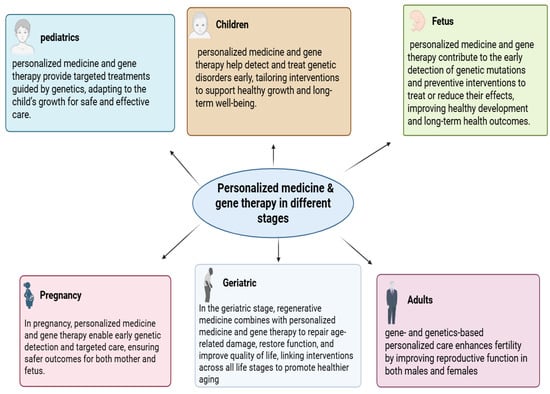-
 Psychiatric and Neuroinflammatory Profiles in Cancer Patients with and Without Type 2 Diabetes
Psychiatric and Neuroinflammatory Profiles in Cancer Patients with and Without Type 2 Diabetes -
 T Helper and Cytotoxic T Cells Play an Important Role in Acute Gastric Injury
T Helper and Cytotoxic T Cells Play an Important Role in Acute Gastric Injury -
 Diabetic Ketoacidosis in Young Adults with Type 1 Diabetes: The Impact of the Ketogenic Diet—A Narrative Literature Review
Diabetic Ketoacidosis in Young Adults with Type 1 Diabetes: The Impact of the Ketogenic Diet—A Narrative Literature Review -
 Real-World Challenges in ctDNA NGS Implementation
Real-World Challenges in ctDNA NGS Implementation
Journal Description
Diseases
Diseases
is an international, peer-reviewed, open access, multidisciplinary journal with focus on research on human diseases and conditions, published monthly online by MDPI.
- Open Access— free for readers, with article processing charges (APC) paid by authors or their institutions.
- High Visibility: indexed within Scopus, ESCI (Web of Science), PubMed, PMC, CAPlus / SciFinder, and other databases.
- Journal Rank: JCR - Q2 (Medicine, Research and Experimental)
- Rapid Publication: manuscripts are peer-reviewed and a first decision is provided to authors approximately 22.7 days after submission; acceptance to publication is undertaken in 2.5 days (median values for papers published in this journal in the first half of 2025).
- Recognition of Reviewers: reviewers who provide timely, thorough peer-review reports receive vouchers entitling them to a discount on the APC of their next publication in any MDPI journal, in appreciation of the work done.
- Sections: published in 8 topical sections.
Impact Factor:
3.0 (2024);
5-Year Impact Factor:
3.4 (2024)
Latest Articles
Tailored Therapeutic Strategies for Fetuses, Neonates, Pediatrics, Geriatrics, Athletes, and Critical Cases in the Era of Personalized Medicine
Diseases 2026, 14(1), 12; https://doi.org/10.3390/diseases14010012 (registering DOI) - 29 Dec 2025
Abstract
►
Show Figures
Precision medicine, which relies on genomic, multi-omic, phenotypic, and environmental data, has the potential to transform healthcare from population-focused heuristics to individualized prevention, diagnosis, and treatment. Moreover, recent advances in sequencing, molecular profiles, wearable sensors, and machine learning have created opportunities for rapid
[...] Read more.
Precision medicine, which relies on genomic, multi-omic, phenotypic, and environmental data, has the potential to transform healthcare from population-focused heuristics to individualized prevention, diagnosis, and treatment. Moreover, recent advances in sequencing, molecular profiles, wearable sensors, and machine learning have created opportunities for rapid translational innovation: rapid genomic diagnosis in neonatal and paediatric rare diseases, targeted oncology, pharmacogenomic-based prescribing strategies, and individual sport performance. Nevertheless, the vast majority of innovations remain in centers of specialism or pilot programs, rather than routinely or equitably integrated into clinical or athletic practice. This narrative review synthesizes translational evidence across the life course—in pregnancy, paediatrics, adult medicine, geriatrics, and sportomics—to find reproducible clinical and performance examples which enable precision-based alternative approaches to management, outcome, or preparation; and to reshape those examples into pragmatic, scalable priorities which minimize inequity, and maximize benefit. We undertook a structured narrative synthesis of peer-reviewed literature, trials, clinician translation programs, implementation studies, and sportomics reports, prioritizing examples that demonstrate utility, reproducibility, and impact. Important findings suggest that multi-omics and rapid sequencing improve diagnostic yield and time to diagnosis. Molecular profiling and circulating tumor DNA help realize adaptive treatment selection. Integrated genomics, metabolomics, wearable physiology, and AI analytics facilitate individualized training, injury-risk stratification, and recovery optimization. But systematic value is limited by insufficient representative validation, dataset bias, poor interoperability, regulatory uncertainty, workforce preparedness, and inequities of access. Converting a promise into population- and performance-level value requires coordinated action across four fronts: representative validation; interoperable, privacy-preserving infrastructures; clinician- and coach-centered implementation; and templates for scalable, cost-sensitive deployment.
Full article
Open AccessArticle
Survival Prediction in Septic ICU Patients: Integrating Lactate and Vasopressor Use with Established Severity Scores
by
Celia María Curieses Andrés, Maria del Pilar Rodriguez del Tio, Ana María Bueno Gonzalez, Mercedes Artola Blanco, Silvia Medina Díez, Amanda Francisco Amador, Elena Bustamante Munguira and José M. Pérez de la Lastra
Diseases 2026, 14(1), 11; https://doi.org/10.3390/diseases14010011 - 29 Dec 2025
Abstract
►▼
Show Figures
Background: Accurate prediction of survival in septic patients remains a major challenge in intensive care medicine. Established severity scores such as the Acute Physiology and Chronic Health Evaluation II (APACHE II) and the Sequential Organ Failure Assessment (SOFA) are widely used to estimate
[...] Read more.
Background: Accurate prediction of survival in septic patients remains a major challenge in intensive care medicine. Established severity scores such as the Acute Physiology and Chronic Health Evaluation II (APACHE II) and the Sequential Organ Failure Assessment (SOFA) are widely used to estimate prognosis, while biochemical markers such as serum lactate may provide complementary information. However, the prognostic interplay between these scores, lactate dynamics, vasopressor requirement, and infection focus has not been fully elucidated in septic populations. Methods: We conducted a retrospective observational study of 146 adult patients with sepsis admitted to the intensive care unit (ICU) of the Hospital Clínico Universitario de Valladolid (HCUV), Spain, between 2022 and 2024. Demographic data, APACHE II and SOFA scores at admission, lactate levels at admission and 24 h, albumin, and procalcitonin were recorded. Vasopressor use (categorized by intensity) and infection focus (urinary vs. non-urinary) were documented. The primary outcome was ICU mortality. Correlation analyses (Pearson or Spearman as appropriate) were performed separately for urinary and non-urinary subgroups. Multivariable logistic regression models were constructed using APACHE II, SOFA, log-transformed lactate at 24 h, vasopressor use, and urinary focus as predictors. Model performance was assessed using Nagelkerke R2, area under the ROC curve (AUC), and classification accuracy. Results: ICU mortality was 23.3%. APACHE II (OR 1.092; p = 0.004) and SOFA (OR 1.185; p = 0.023) were independent predictors of ICU mortality, while log-transformed lactate at 24 h showed a positive trend (OR 1.920; p = 0.066). The addition of urinary focus (protective effect, OR 0.19; p = 0.035) and vasopressor requirement (OR 2.20; p = 0.04) modestly improved model discrimination (Nagelkerke R2 = 0.395). ROC analyses showed AUCs of 0.800 for APACHE + SOFA + log-lactate, 0.824 for the vasopressor model, and 0.833 for the urinary focus model. The best-performing models achieved >85% overall accuracy, with specificity consistently above 95%. Conclusions: In septic ICU patients, APACHE II and SOFA scores remain independent predictors of ICU mortality, and lactate at 24 h adds prognostic value—particularly in non-urinary infections. Vasopressor requirement and infection focus modestly improved model discrimination, underscoring their clinical relevance. These findings suggest that integrating severity scores with selected metabolic and clinical variables may modestly refine survival prediction in septic patients.
Full article
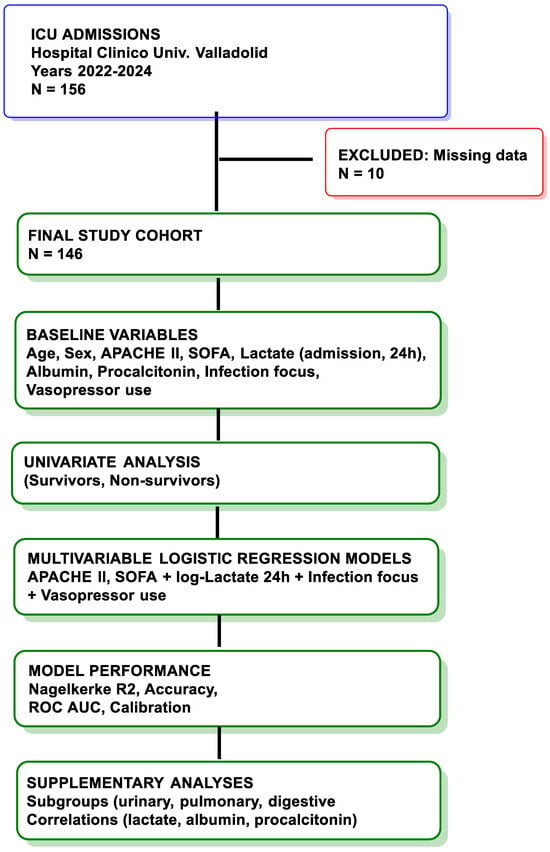
Figure 1
Open AccessReview
Cancer Screening and Prevention in MENA and Mediterranean Populations: A Multi-Level Analysis of Barriers, Knowledge Gaps, and Interventions Across Indigenous and Diaspora Communities
by
Sebahat Gozum, Omar F. Nimri, Mohammed Abdulridha Merzah and Rui Vitorino
Diseases 2026, 14(1), 10; https://doi.org/10.3390/diseases14010010 - 28 Dec 2025
Abstract
►▼
Show Figures
Cancer is one of the biggest health burdens for women in the Middle East and North Africa (MENA), with the incidence of breast, cervical and colorectal cancer on the rise. Although preventive measures such as the HPV vaccination and population-based screening are available,
[...] Read more.
Cancer is one of the biggest health burdens for women in the Middle East and North Africa (MENA), with the incidence of breast, cervical and colorectal cancer on the rise. Although preventive measures such as the HPV vaccination and population-based screening are available, access to them remains very unequal. Women in rural, low-income and refugee communities face additional barriers, cultural stigmatisation, low health literacy, gender norms and fragile health systems, leading to delayed diagnoses and poorer outcomes. This review summarises the results of 724 peer-reviewed publications to assess the current situation of cancer screening in MENA and Mediterranean countries. The studies were classified into four dimensions: cancer type (breast, cervical, colorectal), behavioural constructs (awareness, uptake, education), vulnerability factors (e.g., migrants, refugees, low-literacy groups), and geography (indigenous MENA populations versus diaspora and Mediterranean immigrant communities). The results show large inequalities in access and participation due to fragmented policies, socio-cultural resistance and infrastructure gaps. Nevertheless, promising approaches are emerging: community-led outreach, mobile screening programmes, AI-assisted triage and culturally appropriate digital health interventions. Comparisons between the local and diaspora populations make it clear that systemic and cultural barriers persist even in well-equipped facilities. Closing the screening gap requires a culturally sensitive, digitally enabled and policy aligned approach. Key priorities include engaging religious and community leaders, promoting men’s engagement in women’s health and securing sustainable funding. With coordinated action across all sectors, MENA countries can build inclusive screening programmes that reach vulnerable women and reduce preventable cancer mortality.
Full article
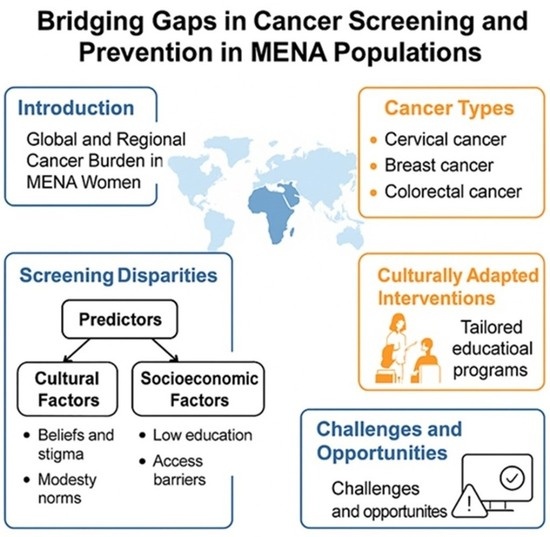
Graphical abstract
Open AccessArticle
Clinical Depression in the Last Year in Life in Persons Dying from Non-Cancer Conditions—Real World Data
by
Peter Strang, Anette Alvariza, Torbjörn Schultz and Linda Björkhem-Bergman
Diseases 2026, 14(1), 9; https://doi.org/10.3390/diseases14010009 - 28 Dec 2025
Abstract
Background/Objectives: Published prevalences of depression are mainly based on measurements of depressive symptoms, whereas data on clinical depressions are lacking. Our aim was to map the prevalence of ICD-10 diagnoses of depression made by physicians in routine healthcare, during the last year of
[...] Read more.
Background/Objectives: Published prevalences of depression are mainly based on measurements of depressive symptoms, whereas data on clinical depressions are lacking. Our aim was to map the prevalence of ICD-10 diagnoses of depression made by physicians in routine healthcare, during the last year of life in non-cancer conditions and to study associations with clinical variables. Methods: A registry study on all persons in ordinary accommodation, dying in 2015–2023 in non-cancer conditions. Results: Of 62,228 persons dying from non-cancer conditions, 4391 (7.1%) were formally diagnosed with depression during the last year in life. Depression was significantly more common in women than in men, 8.0% vs. 6.3% (p < 0.001); adjusted odds ratio (aOR) 1.46 (95%CI 1.37–1.55). Prevalence of depression was highest in persons 18–44 years (18.3%) and lowest in persons >85 years old (5.7%) (p < 0.001); aOR 4.12 (95%CI 3.66–4.63). It was also more common in persons living in more affluent areas, aOR 1.19 (95%CI 1.10–1.29). The condition was most frequent in persons with Parkinson’s disease (9.4%) and COPD (8.2%). Depression was associated with more emergency room visits, 89.5% vs. 81.3% (p < 0.001), and visits in psychiatric services in the last year in life, 41.4% vs. 8.8% (p < 0.001). Depression was less prevalent in persons admitted to palliative care (p = 0.007). Conclusions: The highest frequencies were found in women, younger persons, and those living in affluent areas, but also in certain diagnoses such as Parkinson’s disease and COPD. Clinical depression in the last year of life is associated with more emergency room visits and utilization of psychiatric services.
Full article
(This article belongs to the Special Issue Mental Health Across the Lifespan: Integrating Multidisciplinary Perspectives)
►▼
Show Figures
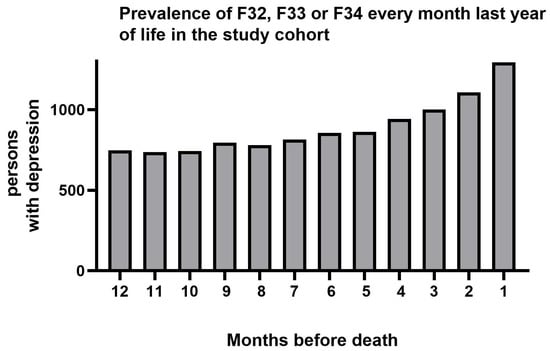
Figure 1
Open AccessArticle
Predictors of Escalation of Lipid-Lowering Therapy with Subanalysis of the Influence of Lipoprotein (a) on the Decision-Making Process
by
Paweł Muszyński, Kinga Natalia Dudzińska, Marlena Święcicka, Wiktoria Grądzka-Matys, Małgorzata Chlabicz, Dominika Musiałowska, Joanna Kruszyńska, Piotr Kazberuk, Urszula Bajda and Anna Tomaszuk-Kazberuk
Diseases 2026, 14(1), 8; https://doi.org/10.3390/diseases14010008 - 27 Dec 2025
Abstract
Background/Objectives: Cardiovascular diseases are the leading cause of death worldwide. The preventive efforts to reduce the burden are crucial. Primary causes of cardiovascular diseases include lipid disorders. The variety of available medications influences cardiovascular risk and allows for improvement. However, discontinuation or infrequent
[...] Read more.
Background/Objectives: Cardiovascular diseases are the leading cause of death worldwide. The preventive efforts to reduce the burden are crucial. Primary causes of cardiovascular diseases include lipid disorders. The variety of available medications influences cardiovascular risk and allows for improvement. However, discontinuation or infrequent initiation of lipid-lowering therapies remains a problem. This study aimed to investigate predictors of lipid-lowering therapy escalation. Methods: 431 patients with known concentrations of Lipoprotein (a) (Lp (a)) acquired as part of routine cardiovascular risk assessment from the HELPE-R registry, hospitalised in the University Clinical Hospital in Białystok were included in this study. Escalation of treatment was defined as the initiation of any form of lowering therapy or an increase in the potency or dose of statins. The analysis of the influence of various factors on the decision about escalation was performed. Results: The median age was 69.00 years. The escalation of therapy occurred in 48.49% of patients. Not reaching the LDL-C goal was the strongest predictor of escalation (OR: 9.177). The other factors increasing the probability of escalation included acute coronary syndrome (OR: 3.913), prediabetes (OR: 2.372), chronic coronary syndrome (OR: 2.217), dyslipidemia (OR: 2.354), hypertension (OR: 1.734), carotid artery stenosis (OR: 1.625), and obesity (OR: 1.543). There was no effect of past MI and stroke on the escalation of lipid profile. Lp (a) did not affect the escalation. Conclusions: The decision about escalation of lipid-lowering therapy is mainly influenced by classical risk factors and established atherosclerotic disease. Lp (a) did not affect the escalation, despite growing interest among medical practitioners.
Full article
(This article belongs to the Special Issue Insights into the Management of Cardiovascular Disease Risk Factors)
►▼
Show Figures
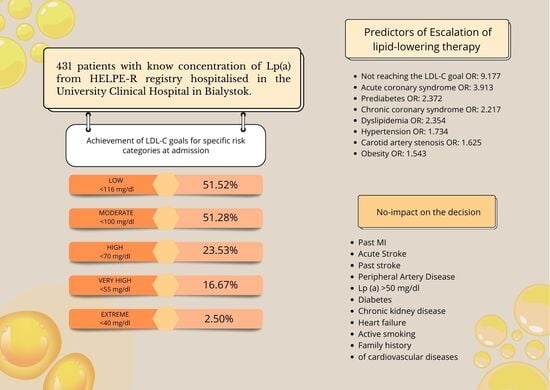
Graphical abstract
Open AccessReview
Genetics of Sudden Cardiac Death
by
Martina Lovrić Benčić and Rea Levicki
Diseases 2026, 14(1), 7; https://doi.org/10.3390/diseases14010007 - 27 Dec 2025
Abstract
Introduction: Cardiomyopathies (DCM, HCM, and ACM) and primary arrhythmogenic disorders (BrS, LQTS, and CPVT) represent the most common causes of sudden cardiac death (SCD) in young individuals. Systematic genome-wide single-nucleotide polymorphism (SNP) analyses and genome-wide association studies (GWASs) have enabled the identification of
[...] Read more.
Introduction: Cardiomyopathies (DCM, HCM, and ACM) and primary arrhythmogenic disorders (BrS, LQTS, and CPVT) represent the most common causes of sudden cardiac death (SCD) in young individuals. Systematic genome-wide single-nucleotide polymorphism (SNP) analyses and genome-wide association studies (GWASs) have enabled the identification of numerous genetic variants associated with cardiovascular diseases. Body: Genetic testing for cardiomyopathies and inherited channelopathies primarily involves panel testing of genes with definitive and strong evidence of disease association; genes supported by moderate evidence may also be considered. Cardiomyocytes express a variety of proteins implicated in the pathogenesis of genetic cardiomyopathies, including sarcomeric, cytoskeletal, desmosomal, and nuclear envelope proteins. Inherited cardiac channelopathies result from mutations in genes encoding cellular components that influence calcium ion availability or affect membrane ion channels, including sodium, potassium, and calcium channels. Common variants associated with SCD are found in genes encoding cardiac ion channels (e.g., SCN5A, KCNQ1, and KCNH2), calmodulin (CALM2), sarcomeric proteins (MYH7, MYBPC3, TTN, and TNNI3), and desmosomal proteins (RyR2 and DES). Conclusions: This review demonstrates that specific genetic variants are significantly associated with an increased risk of SCD. The evidence underscores the importance of genetic screening and early intervention in individuals with a family history of SCD or other risk factors for inherited cardiac disorders predisposing to SCD. Future research should focus on gene-specific management strategies for familial cardiomyopathies and inherited channelopathies, with the goal of improving targeted genetic therapies and reducing the burden of sudden cardiac death.
Full article
Open AccessArticle
Impact of Sacubitril/Valsartan on Cardiac Reverse Remodeling in Patients with Heart Failure Undergoing Cardiac Resynchronization Therapy
by
Tariel Atabekov, Irina Silivanova, Irina Kisteneva, Sergey Krivolapov, Roman Batalov and Sergey Popov
Diseases 2026, 14(1), 6; https://doi.org/10.3390/diseases14010006 - 27 Dec 2025
Abstract
►▼
Show Figures
Background/Objectives: Many heart failure (HF) patients exhibit a suboptimal response to cardiac resynchronization therapy (CRT). This study investigated whether sacubitril/valsartan, a drug known to beneficially impact cardiac remodeling, could improve outcomes for patients undergoing CRT implantation. Methods: In this single-center, observational study, 90
[...] Read more.
Background/Objectives: Many heart failure (HF) patients exhibit a suboptimal response to cardiac resynchronization therapy (CRT). This study investigated whether sacubitril/valsartan, a drug known to beneficially impact cardiac remodeling, could improve outcomes for patients undergoing CRT implantation. Methods: In this single-center, observational study, 90 HF patients (left ventricular ejection fraction [LVEF] ≤ 35%) receiving a CRT-defibrillator were stratified into a sacubitril/valsartan group (n = 39) and a control group (n = 51). The primary endpoint was a CRT response at 12 months, defined as improvement in New York Heart Association (NYHA) class, left ventricular reverse remodeling (≥15% reduction in left ventricular end-systolic volume [LVESV] or ≥5% improvement in LVEF), and freedom from HF hospitalization. Results: The sacubitril/valsartan group had a significantly higher CRT response rate (87.2% vs. 64.7%, p = 0.016). They also showed greater improvement in the 6 min walk test (p = 0.013), NYHA class (p = 0.017), reduction in LVESV (p = 0.025), and QRS duration (p = 0.005). Multivariable analysis confirmed sacubitril/valsartan as an independent predictor of CRT response (OR = 4.43; 95% CI: 1.33–14.71; p = 0.015). Conclusions: In this study of HF patients receiving CRT, sacubitril/valsartan was independently associated with superior reverse remodeling, enhanced electrical resynchronization, and a higher rate of CRT response. These findings suggest a potential synergistic role for sacubitril/valsartan in optimizing post-CRT outcomes; however, as this was an observational study, they should be considered hypothesis-generating and require validation in larger, randomized controlled trials.
Full article
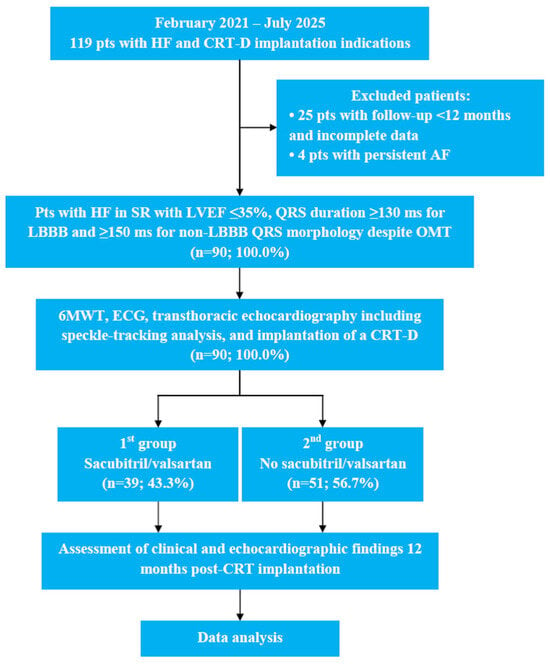
Figure 1
Open AccessArticle
Unveiling Mucopolysaccharidosis IIIC in Brazil: Diagnostic Journey and Clinical Features of Brazilian Patients Identified Through the MPS Brazil Network
by
Yorran Hardman Araújo Montenegro, Maria Fernanda Antero Alves, Simone Silva dos Santos-Lopes, Carolina Fischinger Moura de Souza, Fabiano de Oliveira Poswar, Ana Carolina Brusius-Facchin, Fernanda Bender-Pasetto, Kristiane Michelin-Tirelli, Fernanda Medeiros Sebastião, Franciele Barbosa Trapp, Erlane Marques Ribeiro, Paula Frassinetti Vasconcelos de Medeiros, Chong Ae Kim, Emilia Katiane Embiraçu, Mariluce Riegel-Giugliani, Guilherme Baldo and Roberto Giugliani
Diseases 2026, 14(1), 5; https://doi.org/10.3390/diseases14010005 - 26 Dec 2025
Abstract
►▼
Show Figures
Background: Mucopolysaccharidosis type IIIC (MPS IIIC) is a rare lysosomal storage disorder caused by pathogenic variants in the HGSNAT gene. Data from large patient cohorts remain scarce, particularly in Latin America. Methods: We retrospectively analyzed clinical, biochemical, and genetic data from patients diagnosed
[...] Read more.
Background: Mucopolysaccharidosis type IIIC (MPS IIIC) is a rare lysosomal storage disorder caused by pathogenic variants in the HGSNAT gene. Data from large patient cohorts remain scarce, particularly in Latin America. Methods: We retrospectively analyzed clinical, biochemical, and genetic data from patients diagnosed with MPS IIIC through the MPS Brazil Network. Diagnosis was based on reduced activity of acetyl-CoA:α-glucosaminide N-acetyltransferase (HGSNAT), elevated urinary glycosaminoglycans (uGAGs), and/or molecular genetics tests. Results: A total of 101 patients were confirmed with MPS IIIC, representing one of the largest cohorts worldwide. Females accounted for 60% of cases. The mean age at symptom onset was 5.4 ± 3.9 years, while the mean age at diagnosis was 11.7 ± 6.9 years, reflecting a 6-year diagnostic delay. Most patients initially presented with developmental delay (82%) and facial dysmorphism (80%), whereas behavioral manifestations were less frequently identified (25%), suggesting a milder phenotype than previously reported. Genetic information was available for 28% of patients, showing recurrent alleles (c.372-2A>G, c.252dupT) and several novel mutations, which expand the mutational spectrum of the disease. Genotype–phenotype similarities with Portuguese, Italian, and Chinese cases suggest shared ancestry contributions. Regional differences included earlier diagnoses in the North of Brazil and high consanguinity rates in the Northeast region. Conclusions: This study describes the largest Brazilian cohort of MPS IIIC, documenting novel variants and regional heterogeneity. Findings highlight diagnostic delays, ancestry influences, and the urgent need for disease-modifying therapies.
Full article

Figure 1
Open AccessReview
Μaximal Fat Oxidation During Cycle Ergometer Protocols in Obese Adults: A Scoping Review
by
Konstantinos Anagnostopoulos, Apostolos Spassis, Christos Kokkotis, Ilias Smilios, Athanasios Chatzinikolaou, Helen T. Douda and Alexios Batrakoulis
Diseases 2026, 14(1), 4; https://doi.org/10.3390/diseases14010004 - 24 Dec 2025
Abstract
Maximal fat oxidation (MFO) rate and the intensity at which it occurs (Fatmax) are key indicators of metabolic flexibility, yet their assessment in obese populations poses methodological challenges. This scoping review synthesizes evidence from 23 studies investigating protocols for determining Fatmax and MFO
[...] Read more.
Maximal fat oxidation (MFO) rate and the intensity at which it occurs (Fatmax) are key indicators of metabolic flexibility, yet their assessment in obese populations poses methodological challenges. This scoping review synthesizes evidence from 23 studies investigating protocols for determining Fatmax and MFO during cycle ergometry. Across studies, obese and sedentary participants followed testing procedures, typically involving lower initial workloads, smaller workload increments, and longer stage durations than those used for fitter individuals. In obese populations, Fatmax generally occurred at 30–50% of VO2 peak, compared with values exceeding 60% in trained participants. While the reliability of Fatmax was acceptable, greater variability was observed for MFO rate. Fitness level appeared to exert a stronger influence than adiposity on fat oxidation, with obesity often associated with a left-shifted fat oxidation curve. Additional factors such as gender, developmental stage, insulin resistance, and type 2 diabetes further modulated these responses. Importantly, short-term training interventions, including moderate-intensity exercise, high-intensity interval training, and Fatmax-targeted protocols, consistently enhanced MFO and shifted Fatmax toward higher intensities, with favorable effects on insulin sensitivity and metabolic health. In contrast, nutritional and supplementation studies provided limited evidence of additional benefits. Overall, Fatmax assessment is feasible in obese populations when appropriate methodological adjustments are applied, and exercise interventions can rapidly enhance fat oxidation capacity. Future research should focus on protocol standardization, mechanistic exploration, and long-term interventions to clarify the role of Fatmax in obesity management and its potential clinical applications.
Full article
(This article belongs to the Special Issue Body Composition, Energy Expenditure and Lifestyle During Obesity Management)
►▼
Show Figures

Figure 1
Open AccessArticle
Five-Year Incidence of Urinary Incontinence in 68,066 Breast Cancer Patients Followed in Gynecology Practices in Germany
by
Lara Ilona Becker, Karel Kostev and Matthias Kalder
Diseases 2026, 14(1), 3; https://doi.org/10.3390/diseases14010003 - 24 Dec 2025
Abstract
►▼
Show Figures
Purpose: Previous data showed an increased risk of developing urinary incontinence in breast cancer patients. However, there is a lack of studies including both pre and postmenopausal women. The aim of this study was to analyze the incidence of subsequent urinary incontinence in
[...] Read more.
Purpose: Previous data showed an increased risk of developing urinary incontinence in breast cancer patients. However, there is a lack of studies including both pre and postmenopausal women. The aim of this study was to analyze the incidence of subsequent urinary incontinence in breast cancer patients and variables associated with an increased urinary incontinence. Methods: This study utilized IQVIA Disease Analyzer database to examine the five-year cumulative incidence of urinary incontinence among 68,066 women diagnosed with breast cancer in gynecological practices in Germany between January 2005 and December 2021 by using Kaplan–Meier curves, stratified by age group. Multivariable Cox regression models were conducted to assess the association between age, co-diagnoses, and endocrine therapy (tamoxifen, aromatase inhibitors) and incident urinary incontinence. Results: Within five years of the start of follow-up, 5.8% of women were diagnosed with urinary incontinence. Age (HR = 1.36; 95% CI = 1.21–1.54 for age 51–60; HR = 2.06; 95% CI = 1.84–2.31 for age group 61–70 and HR = 2.71; 95% CI = 2.42–3.04 for age group >70 as compared to age group ≤50), depression (HR = 1.41; 95% CI: 1.25–1.59) and menopausal and other perimenopausal disorders (HR = 1.21; 95% CI: 1.10–1.27) were associated with an increased urinary incontinence risk. The association was negative and statistically significant for aromatase inhibitor therapy (HR = 0.71; 95% CI: 0.66–0.78) as compared to women without endocrine therapy, whereas tamoxifen therapy was not associated with decreased or increased urinary incontinence risk. Conclusions: In conclusion, this study reports an 5.8% incidence of urinary incontinence within five years after breast cancer diagnosis. Age-related differences and co-diagnoses should be taken into account.
Full article

Figure 1
Open AccessArticle
The Impact of Proactive Fecal Calprotectin Collection in an Outreach Protocol for Biologic-Naïve Ulcerative Colitis Patients–Ulcerative Colitis Clinical Outreach (UCCO)
by
Scott MacKay, Denise Parsons, Candace Hagerman, Ellina Lytvyak, Levinus Dieleman, Frank Hoentjen, Karen Kroeker, Farhad Peerani, Karen Wong, Michal Gozdzik, Kunihiko Oguro, Todd McMullen and Brendan Halloran
Diseases 2026, 14(1), 2; https://doi.org/10.3390/diseases14010002 - 22 Dec 2025
Abstract
►▼
Show Figures
Background: Ulcerative colitis (UC) is a chronic, relapsing inflammatory bowel disease that requires regular monitoring. The University of Alberta IBD Unit piloted a proactive outreach protocol for biologic-naïve UC patients, including clinical and biochemical variables, and assessed its impact on UC care. Methods:
[...] Read more.
Background: Ulcerative colitis (UC) is a chronic, relapsing inflammatory bowel disease that requires regular monitoring. The University of Alberta IBD Unit piloted a proactive outreach protocol for biologic-naïve UC patients, including clinical and biochemical variables, and assessed its impact on UC care. Methods: Biologic-naïve UC patients without follow-up for ≥6 months were recruited by phone and completed Partial Mayo, modified Sutherland Index, and MARS-5 questionnaires, as well as blood work and fecal calprotectin (FCP). Results were sent to each patient’s gastroenterologist, who then completed a survey about intended UC management changes. Results: 81 patients completed the protocol. UC management was changed in 45 (55.6%) cases, with 82.2% of changes being expedited follow-up or management escalation. Six patients had active flares, and 17 with asymptomatic inflammation were identified. 23 patients underwent endoscopy, with 10 (43.4%) showing active disease. Six patients started biologic therapies based on protocol and endoscopic findings. UC management escalations were significantly predicted by FCP and Sutherland Index scores on logistic regression analysis. 86.4% of gastroenterologists rated the protocol helpful. Conclusions: Patient care can be improved by a one-time, proactive outreach program for biologic-naïve UC. Outreach and monitoring in biologic-naïve UC should include assessment of both FCP and clinical markers to improve UC management.
Full article
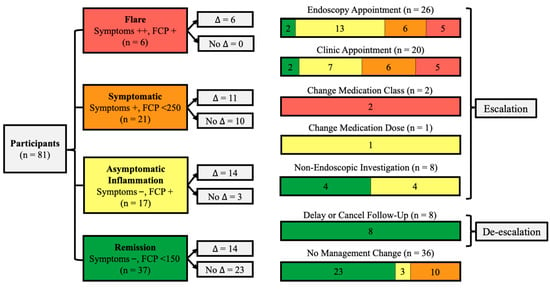
Figure 1
Open AccessReview
Coexistence of Hypertrophic Cardiomyopathy and Arterial Hypertension: Current Insights and Future Directions
by
Vasiliki Katsi, Konstantia Papadomarkaki, Konstantinos Manousiadis, Epameinondas Triantafyllou, Christos Fragoulis and Konstantinos Tsioufis
Diseases 2026, 14(1), 1; https://doi.org/10.3390/diseases14010001 - 22 Dec 2025
Abstract
Background: Hypertrophic cardiomyopathy (HCM) is the most common inherited cardiac disease. Arterial hypertension represents the leading modifiable risk factor for cardiovascular morbidity and mortality globally. Their coexistence is frequent, affecting approximately 40–60% of adults with HCM, yet the implications of this overlap remain
[...] Read more.
Background: Hypertrophic cardiomyopathy (HCM) is the most common inherited cardiac disease. Arterial hypertension represents the leading modifiable risk factor for cardiovascular morbidity and mortality globally. Their coexistence is frequent, affecting approximately 40–60% of adults with HCM, yet the implications of this overlap remain insufficiently investigated. Methods: We conducted a narrative review of the existing literature addressing the clinical profile and management strategies in patients with concomitant HCM and hypertension. Particular emphasis was placed on pharmacologic treatment and the role of emerging therapies for this population. Results: Patients with both conditions are generally older, with more cardiometabolic comorbidities and greater functional limitation than those with isolated HCM. Hypertension may confound diagnosis and is linked to a higher prevalence of atrial fibrillation and stroke. Its effect on ventricular arrhythmias, sudden cardiac death and mortality is less clear. Management is challenging, as vasodilatory antihypertensives can exacerbate left ventricular outflow tract obstruction. β-blockers and non-dihydropyridine calcium channel blockers are preferred, while novel agents such as myosin inhibitors and SGLT2 inhibitors show potential but require further study. Conclusions: The coexistence of HCM and hypertension is frequent but insufficiently studied, with major implications for diagnosis and treatment. Further research is essential to optimize management and outcomes.
Full article
(This article belongs to the Special Issue Feature Papers in Section 'Cardiology' in 2024–2025)
Open AccessArticle
Efficacy of Polyvinylpyrrolidone–Zinc Gluconate and Taurine Gel in the Prophylaxis of Oral Mucositis in Adults Undergoing High-Dose Chemotherapy and Allogeneic Stem Cell Transplantation
by
Gaetana Porto, Annalisa Pitino, Mercedes Gori, Martina Pitea, Maria Eugenia Alvaro, Giovanni Luigi Tripepi, Giorgia Policastro, Fortunata Martino, Rosalba Daniela Minniti, Jessyca Germano’, Barbara Loteta, Giovanna Utano, Erica Bilardi, Francesca Cogliandro, Caterina Alati, Violetta Marafioti, Graziella D’Arrigo and Massimo Martino
Diseases 2025, 13(12), 408; https://doi.org/10.3390/diseases13120408 - 18 Dec 2025
Abstract
Background: Oral mucositis (OM) is a significant complication after allogeneic stem cell transplantation. Objectives: This prospective, observational cohort study assessed the effectiveness of a polyvinylpyrrolidone-zinc gluconate and taurine (PVP-ZG-TAU) oral gel in managing OM. The primary objective was to determine whether the gel
[...] Read more.
Background: Oral mucositis (OM) is a significant complication after allogeneic stem cell transplantation. Objectives: This prospective, observational cohort study assessed the effectiveness of a polyvinylpyrrolidone-zinc gluconate and taurine (PVP-ZG-TAU) oral gel in managing OM. The primary objective was to determine whether the gel reduced the incidence and grade of OM and accelerated its resolution. Methods: The study enrolled 82 patients; 39 received the PVP-ZG-TAU gel, and 43 represented a historical control group. To prevent oral mucositis, both groups maintained good oral hygiene. In the experimental group, patients received three sprays of PVP-ZG-TAU gel, three times a day, from the start of conditioning chemotherapy until day +15 after allo-SCT. Results: In the PVP-ZG-TAU group, 79.1% patients experienced grade 1–2 OM and 20.9% experienced grade 3–4 OM. In the control group, 74.4% had grade 1–2 OM, and 25.6% had grade 3–4 OM (p = ns). Resolution occurred significantly faster in the PVP-ZG-TAU group, with an 84% resolution rate per 100 person-weeks, compared with 62% in the control group. Cox regression analysis revealed that treatment was associated with a 68% greater likelihood of earlier resolution (adjusted hazard ratio [HR], 1.68; 95% confidence interval [CI], 1.03–2.74; p = 0.036). Conclusions: These findings suggest that PVP-ZG-TAU can reduce OM duration and serve as a supportive intervention for allo-SCT patients.
Full article
Open AccessArticle
Gaps in Community-Based Screening for Non-Communicable Diseases in Saudi Arabia
by
Ghadeer Al Ghareeb, Zaenab M. Alkhair, Zainab Alradwan, Hussain Alqaissoom, Horiah Ali Soumel, Khadijah R. Alsaffar, Fatema Muhaimeed, Burair Alsaihati, Mohammad N. Alkhrayef and Ibrahim Alradwan
Diseases 2025, 13(12), 407; https://doi.org/10.3390/diseases13120407 - 18 Dec 2025
Abstract
►▼
Show Figures
Background: Non-communicable diseases (NCDs) such as cardiovascular diseases, diabetes, obesity, and cancer are the leading cause of mortality globally and in Saudi Arabia, accounting for more than 70% of all deaths. Despite national initiatives offering free preventive services, screening uptake remains low. This
[...] Read more.
Background: Non-communicable diseases (NCDs) such as cardiovascular diseases, diabetes, obesity, and cancer are the leading cause of mortality globally and in Saudi Arabia, accounting for more than 70% of all deaths. Despite national initiatives offering free preventive services, screening uptake remains low. This study aimed to describe the demographic and clinical characteristics of individuals participating in community-based NCD screening campaigns in the Eastern Province of Saudi Arabia and to evaluate screening uptake, compliance, and diagnostic outcomes. Methods: A retrospective cross-sectional analysis was conducted among 3106 adults screened at volunteer-driven community campaigns held between January 2023 and December 2024. Screening included anthropometric measurements, blood pressure assessment, and glucose testing, followed by eligibility evaluation for osteoporosis and cancer screening. Uptake and compliance were verified using electronic health records. Descriptive and inferential statistical analyses were applied. Results: Participants were 64% male and 36% female, with a mean age of 41.4 ± SD years. Obesity, hypertension, and diabetes were identified in 32%, 31%, and 12% of participants overall. Gender-stratified prevalence showed higher obesity among females at 36% (95% CI 32.3 to 38.1) and higher hypertension and diabetes among males at 36% (95% CI 34.0 to 38.2) and 14% (95% CI 12.1 to 15.2), respectively. Uptake among eligible individuals was 51% for dual-energy X-ray absorptiometry (DEXA), 47% for fecal immunochemical testing (FIT), 43% for Pap smear, and 39% for mammography. Diagnostic findings demonstrated substantial undetected disease burden, including osteoporosis in 41% (95% CI 26.0 to 56.8) of DEXA scans, a FIT positivity rate of 5% (95% CI 1.5 to 10.3), abnormal Pap cytology in 3% (95% CI 1.1 to 7.5), and BI-RADS 0 mammograms in 19% (95% CI 11.9 to 29.5), reflecting incomplete assessments requiring further evaluation. Conclusions: Community-based campaigns can effectively resolve limited engagement in health promotional activities and detect substantial burdens of undiagnosed NCDs. However, improvements in referral tracking, follow-up systems, and culturally tailored health education are essential to enhance screening compliance and early detection outcomes. These results can be utilized to inform public policies by extending screening services to additional areas, increasing investment in preventive health campaigns, and enhancing the capacity of the health system.
Full article

Figure 1
Open AccessArticle
Establishment of a Flow Cytometry Protocol for Binarily Detecting Circulating Tumor Cells with EGFR Mutation
by
Cheng-Yu Chang, Chia-Chun Tu, Shian-Ren Lin, Chih-Hao Fang, Po-Wei Tseng, Wan-En Liao, Li-Yun Huang, Shiu-Lan Wang, Wan-Yu Lai, Yee Chao, Yen-Ling Chiu and Jan-Mou Lee
Diseases 2025, 13(12), 406; https://doi.org/10.3390/diseases13120406 - 17 Dec 2025
Abstract
►▼
Show Figures
Background: Patients with EGFR-mutated non-small cell lung cancer (NSCLC) respond well to EGFR tyrosine kinase inhibitors (TKIs), but current EGFR mutation profiling relies on invasive tumor biopsies. Developing less invasive approaches, particularly proteomic evaluation of circulating tumor cells (CTCs) for EGFR mutation profiling,
[...] Read more.
Background: Patients with EGFR-mutated non-small cell lung cancer (NSCLC) respond well to EGFR tyrosine kinase inhibitors (TKIs), but current EGFR mutation profiling relies on invasive tumor biopsies. Developing less invasive approaches, particularly proteomic evaluation of circulating tumor cells (CTCs) for EGFR mutation profiling, remains crucial. Methods: A flow cytometry method for detecting EGFRL858R-bearing CTCs was established by spiking NCI-H1975 cells into blood from cancer-naive donors. The method was then applied to blood samples from 21 NSCLC patients and 10 cancer-naive donors. Results: The gating strategy was defined by CD45−CK-7/8+CK-14/15/16/19−EpCAM+vimentin+EGFRL858R, with a cut-off value of 5 cells/mL. The method yielded positive results in all seven patients with the EGFRL858R mutation and negative results in all ten cancer-naive donors. Compared to the PCR-based reference method, the approach showed 100% positive and 71% negative agreement. Crucially, our in-house method detected EGFRL858R-bearing CTCs in three patients initially identified as EGFR wild-type and one patient with a different EGFR mutation. The remaining samples were concordant with PCR. Notably, two patients with these discordant results received EGFR-TKIs and experienced partial responses. Conclusions: This study introduces a feasible, less invasive proteomic approach for binarily detecting EGFR mutations in CTCs, offering a novel means for patient identification.
Full article

Figure 1
Open AccessArticle
Association of Vitamin D Deficiency with Diabetic Nephropathy in Type 2 Diabetes: A Hospital-Based Cross-Sectional Study
by
Shafia Bashir, Geer Mohammad Ishaq, Insha Mushtaq, Mohammad Ashraf Ganie, Imtiyaz Wani, Muteb Alanazi, Ibrahim Asiri, Arshad Hussain, Kashif Ullah Khan and Sirajudheen Anwar
Diseases 2025, 13(12), 405; https://doi.org/10.3390/diseases13120405 - 17 Dec 2025
Abstract
Background/Objective: Diabetic nephropathy (DN), a key microvascular complication of type 2 diabetes (T2DM), drives significant morbidity, mortality, and healthcare costs. Vitamin D deficiency has been linked to renal dysfunction, but its role in DN remains unclear. This study assessed the association between vitamin
[...] Read more.
Background/Objective: Diabetic nephropathy (DN), a key microvascular complication of type 2 diabetes (T2DM), drives significant morbidity, mortality, and healthcare costs. Vitamin D deficiency has been linked to renal dysfunction, but its role in DN remains unclear. This study assessed the association between vitamin D status and DN versus T2DM without nephropathy. Methods: This cross-sectional hospital-based study included 399 participants (299 DN, 100 T2DM without nephropathy) at a tertiary endocrine clinic. Demographic, clinical, and biochemical data, including serum 25(OH)D, were collected. Chi-square and Mann–Whitney compared categorical and continuous variables, respectively, and multinomial logistic regression assessed the association between vitamin D status and DN (p < 0.05). Results: Patients with DN were older (58.2 ± 7.95 vs. 51.4 ± 9.94 years, p < 0.001), had more advanced CKD (stages 2–3b: 84.6% vs. 20.0%, p < 0.001), and higher albuminuria (moderate: 80.3% vs. 19.0%; severe: 18.4% vs. 0%, p < 0.001). They also showed poorer glycemic control, elevated urea and creatinine, lower serum albumin, dyslipidemia, elevated liver enzymes, and higher uric acid (all p < 0.05). Vitamin D deficiency was more prevalent in DN (37.7% vs. 8.0%, p < 0.001). Unadjusted multinomial regression indicated that T2DM patients without nephropathy had a 91% lower risk of vitamin D deficiency (RRR 0.09; 95% CI 0.04–0.19, p < 0.001) and an 87% lower risk of insufficiency (RRR 0.13; 95% CI 0.05–0.26, p < 0.001) compared with DN patients. After adjusting for age, HbA1c, creatinine, duration of diabetes and eGFR, the reduced risk of deficiency remained significant (RRR 0.04; 95% CI 0.01–0.16, p < 0.001), while the association with insufficiency was no longer significant (p = 0.310). Conclusions: This study shows a significant association between vitamin D deficiency and diabetic nephropathy, though its cross-sectional design precludes causal inference. Reverse causality and residual confounding cannot be excluded. Patients with DN had poorer glycemic control, dyslipidemia, and renal function, along with more frequent vitamin D deficiency. Routine vitamin D monitoring may support early detection and risk stratification in T2DM.
Full article
(This article belongs to the Special Issue From Monitoring to Management: Addressing Challenges in Type 1 and Type 2 Diabetes Care)
►▼
Show Figures

Figure 1
Open AccessCase Report
Unusual Neuropsychiatric Presentation of Cryptococcus neoformans Meningoencephalitis in an Immunosuppressed Patient with Rheumatoid Arthritis: A Case Report
by
Sinthia Vidal-Cañas, Manuel David Mayoral-Valencia, Esteban Artunduaga-Cañas, Esteban Pineda-Arias, Danna Alejandra Betancourt Cañas and Daniela Arturo-Terranova
Diseases 2025, 13(12), 404; https://doi.org/10.3390/diseases13120404 - 17 Dec 2025
Abstract
Central nervous system (CNS) cryptococcosis caused by Cryptococcus neoformans is a severe opportunistic infection that primarily affects individuals with impaired cellular immunity. Although the classic presentation includes headache, fever, and meningeal signs, chronically immunosuppressed patients may develop atypical neuropsychiatric manifestations, leading to diagnostic
[...] Read more.
Central nervous system (CNS) cryptococcosis caused by Cryptococcus neoformans is a severe opportunistic infection that primarily affects individuals with impaired cellular immunity. Although the classic presentation includes headache, fever, and meningeal signs, chronically immunosuppressed patients may develop atypical neuropsychiatric manifestations, leading to diagnostic delays. We report the case of a 53-year-old man with rheumatoid arthritis (RA) receiving long-term prednisolone and etanercept therapy, who presented with a 7-day history of depressive mood, anhedonia, social withdrawal, irritability, and progressive confusion. Neurological examination revealed disorientation without focal deficits. Brain imaging showed only mild cortical atrophy, and cerebrospinal fluid (CSF) analysis revealed lymphocytic pleocytosis, low glucose, and elevated protein levels. Multiplex PCR (FilmArray®) of CSF identified Cryptococcus neoformans, CSF positive to C. neoformans. The patient was treated with liposomal amphotericin B followed by fluconazole, resulting in gradual improvement of both neurological and psychiatric symptoms. This case highlights an unusual presentation of CNS cryptococcosis in a non-HIV immunosuppressed patient with RA, emphasizing that acute psychiatric or cognitive changes can be the predominant manifestation. Clinicians should consider fungal infections in the differential diagnosis of acute neuropsychiatric symptoms in patients receiving chronic corticosteroid and biologic therapy. Early recognition and molecular diagnosis can facilitate timely antifungal treatment, potentially improving prognosis and reducing morbidity associated with delayed therapy. This report underscores the importance of awareness of atypical presentations of opportunistic infections in immunosuppressed populations.
Full article
(This article belongs to the Section Infectious Disease)
►▼
Show Figures

Figure 1
Open AccessArticle
CT-Based Attenuation Correction Algorithm for Quantitative L-Shell X-Ray Fluorescence Imaging of Gold Nanoparticles in Murine Tumor Tissues
by
Marin Lohff, Gerret Haroske, Theresa Staufer, Jan Scheunemann, Florian Ziegler, Jannis Haak, Kazuya Kabayama, Xuhao Huang, Koichi Fukase and Florian Grüner
Diseases 2025, 13(12), 403; https://doi.org/10.3390/diseases13120403 - 16 Dec 2025
Abstract
►▼
Show Figures
Background: Gold nanoparticles (GNPs) are widely used in nanomedicine as drug carriers, including in targeted radionuclide therapy where therapeutic radionuclides are bound to GNPs. Quantitative assessment of their biodistribution is essential. X-ray fluorescence imaging (XFI) is well suited for detecting high-Z elements, but
[...] Read more.
Background: Gold nanoparticles (GNPs) are widely used in nanomedicine as drug carriers, including in targeted radionuclide therapy where therapeutic radionuclides are bound to GNPs. Quantitative assessment of their biodistribution is essential. X-ray fluorescence imaging (XFI) is well suited for detecting high-Z elements, but its quantitative accuracy is compromised by strong attenuation effects, particularly in L-shell XFI where low-energy fluorescence (~10 to 12 keV) is heavily absorbed in tissue. Methods: We developed a computed tomography (CT)-guided attenuation correction algorithm for L-shell XFI. The method generates energy-dependent attenuation maps from co-registered CT data and performs voxel-wise corrections along both excitation and emission paths. The approach was tested on an ex vivo murine tumor sample resected three hours after intratumoral injection of 34.7 μg PEG-modified GNPs. Results: Application of the CT-guided correction substantially improved the relative accuracy of L-shell XFI reconstructions compared to uncorrected data. The corrected distribution maps showed consistent mass recovery across different measurement geometries, demonstrating that the algorithm compensates for the theoretically expected attenuation due to heterogeneous biological tissue. Conclusions: This study provides a proof-of-principle that CT-based attenuation correction enables more reliable and quantitative L-shell XFI of GNPs in biological samples. The approach represents a promising step toward accurate nanoparticle biodistribution assessment in biomedical research, including preclinical studies in targeted radionuclide therapy.
Full article

Graphical abstract
Open AccessArticle
Fluid Shear Stress Modulates Inflammation in Breast Cancer Microenvironment
by
Abir Abdullah Alamro, Ohood Amin AlSuwaidi, Amani Ahmed Alghamdi, Saba Abdi, Atekah Hazzaa Alshammari and Reem Nasser Alotaibi
Diseases 2025, 13(12), 402; https://doi.org/10.3390/diseases13120402 - 15 Dec 2025
Abstract
Background: Fluid shear stress (FSS) is a biomechanical force that can produce phenotypic changes in the cells that are directly in contact with the flow of fluid. Accumulating evidence indicates high FSS to possess the potential ability to prevent tumor development and suppress
[...] Read more.
Background: Fluid shear stress (FSS) is a biomechanical force that can produce phenotypic changes in the cells that are directly in contact with the flow of fluid. Accumulating evidence indicates high FSS to possess the potential ability to prevent tumor development and suppress cancer growth. However, the exact mechanism of its antitumorigenic effects is still not clear. Objective: In this study, we aimed to investigate the effect of FSS on breast cancer microenvironment via macrophage modulation. Methods: We exposed THP-1 like-macrophages to different levels of FSS. The supernatant from THP1-like-macrophages after exposure to FSS was used as conditioned medium (FSS-CM). Subsequently, we analyzed human breast cancer cells, MCF-7, and endothelial cells, as well as HUVECs cultured with FSS-CM. Results: Study outcomes have demonstrated that low FSS-CM inhibited apoptosis as well as induced tumor migration in MCF-7 cells. Conversely, high FSS-CM promoted apoptosis, inhibited tumor migration, and induced G1-phase arrest in MCF-7 cells. Furthermore, low FSS-CM was found to promote proliferation of HUVECs. Conclusions: In conclusion, this study highlights the complex interplay between FSS and cancer cell behavior. Our findings provide in vitro evidence that high FSS exerts an anti-cancer effect by promoting THP-1-like macrophage polarization toward an anti-tumor phenotype, leading to increased apoptosis and reduced migration in MCF-7 cells. These results suggest that the modulation of macrophage polarization may underlie the therapeutic potential of high FSS in suppressing breast cancer progression.
Full article
(This article belongs to the Section Oncology)
►▼
Show Figures

Figure 1
Open AccessArticle
Association Between Obesity and Serum Leptin Levels in Brazilian Female Shift Workers
by
Raquel Toresan Andretta, Janaína Cristina da Silva, Anderson Garcez, Ingrid Stähler Kohl, Karina Giane Mendes, Thais Basso, Maria Teresa Anselmo Olinto and Heloísa Theodoro
Diseases 2025, 13(12), 401; https://doi.org/10.3390/diseases13120401 - 15 Dec 2025
Abstract
►▼
Show Figures
Background: Leptin is a hormone that plays a crucial role in regulating energy homeostasis and it is associated with adiposity. Women engaged in work shifts are often exposed to circadian disruption and metabolic changes that may contribute to increased adiposity and hormonal imbalance.
[...] Read more.
Background: Leptin is a hormone that plays a crucial role in regulating energy homeostasis and it is associated with adiposity. Women engaged in work shifts are often exposed to circadian disruption and metabolic changes that may contribute to increased adiposity and hormonal imbalance. Thus, this study aimed to investigate the association between general and abdominal obesity and serum leptin levels among female shift workers. Methods: This cross-sectional study included a sample of 302 female employees from a group of plastic manufacturing industries in southern Brazil. Serum leptin levels were measured, with values > 15.2 ng/mL classified as elevated. General obesity (body mass index ≥ 30 kg/m2) and abdominal obesity (waist circumference ≥ 88 cm) were assessed. Associations were examined using Poisson regression with robust variance. Results: The mean age of participants was 35.4 ± 10.1 years. The mean serum leptin concentration in the sample was 33.6 ng/mL (95% Confidence Interval [CI]: 30.6–36.6), and the prevalence of altered serum leptin levels was 78.1% (95% CI: 73.5–82.8). After adjustment for potential confounders, women with obesity showed a 63% higher probability of having elevated leptin levels (Prevalence Ratio [PR] = 1.63; 95% CI: 1.32–2.02; p < 0.001) compared with those without obesity. Additionally, significant associations were observed with work shift and physical activity. However, abdominal obesity was not statistically significant after adjustment. Conclusions: Obesity was independently associated with elevated serum leptin levels among female shift workers, suggesting that excess adiposity remains a key determinant of leptin dysregulation in this population.
Full article
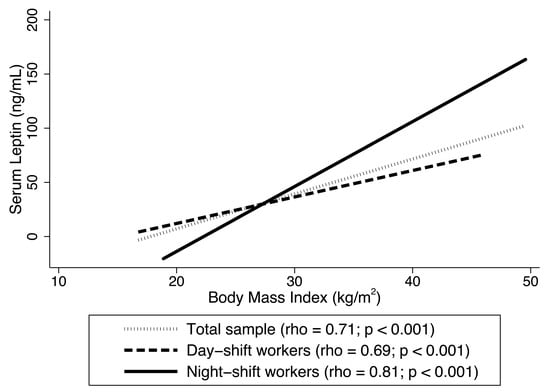
Figure 1
Highly Accessed Articles
Latest Books
E-Mail Alert
News
Topics
Topic in
Biomolecules, Cancers, Diseases, Neurology International, Biomedicines, Organoids
Brain Cancer Stem Cells and Their Microenvironment
Topic Editors: Maria Patrizia Stoppelli, Luca Colucci-D'Amato, Francesca BianchiniDeadline: 31 December 2025
Topic in
Biomedicines, Diseases, JCM, JPM, Uro, Reports
Clinical, Translational, and Basic Research and Novel Therapy on Functional Bladder Diseases and Lower Urinary Tract Dysfunctions
Topic Editors: Hann-Chorng Kuo, Yao-Chi Chuang, Chun-Hou LiaoDeadline: 31 December 2026
Topic in
Dietetics, Diseases, Foods, Nutrients, JCM
Environmental Influences on Dietary Patterns and Disease Risk: Nutritional Pathways and Health Implications
Topic Editors: Yuquan Chen, Guanhu YangDeadline: 1 February 2027
Topic in
Life, Biomedicines, JCRM, Diseases, Emergency Care and Medicine, Anesthesia Research
Electrolytes and Acid-Base Disturbances: Advances in Pathophysiology and Treatment
Topic Editors: Caterina Carollo, Giuseppe MulèDeadline: 30 March 2027

Conferences
Special Issues
Special Issue in
Diseases
Advanced Research and Practice in Acute and Chronic Pancreatitis
Guest Editors: Veysel Tahan, Ebubekir DaglilarDeadline: 31 December 2025
Special Issue in
Diseases
COVID-19 and Global Chronic Disease 2025: New Challenges
Guest Editors: Ludovico Abenavoli, Filippo LococoDeadline: 31 December 2025
Special Issue in
Diseases
Surgical Aspects of Ovarian/Tubal/Peritoneal Cancer Management
Guest Editors: Neville F. Hacker, Jacobus van der VeldenDeadline: 31 December 2025
Special Issue in
Diseases
Research Topics in Thrombosis-Inducing Diseases
Guest Editors: Robert Maitta, Yi Yuan ZhouDeadline: 31 December 2025
Topical Collections
Topical Collection in
Diseases
Lysosomal Storage Diseases
Collection Editors: José A. Sánchez-Alcázar, Luis Jiménez Jiménez



